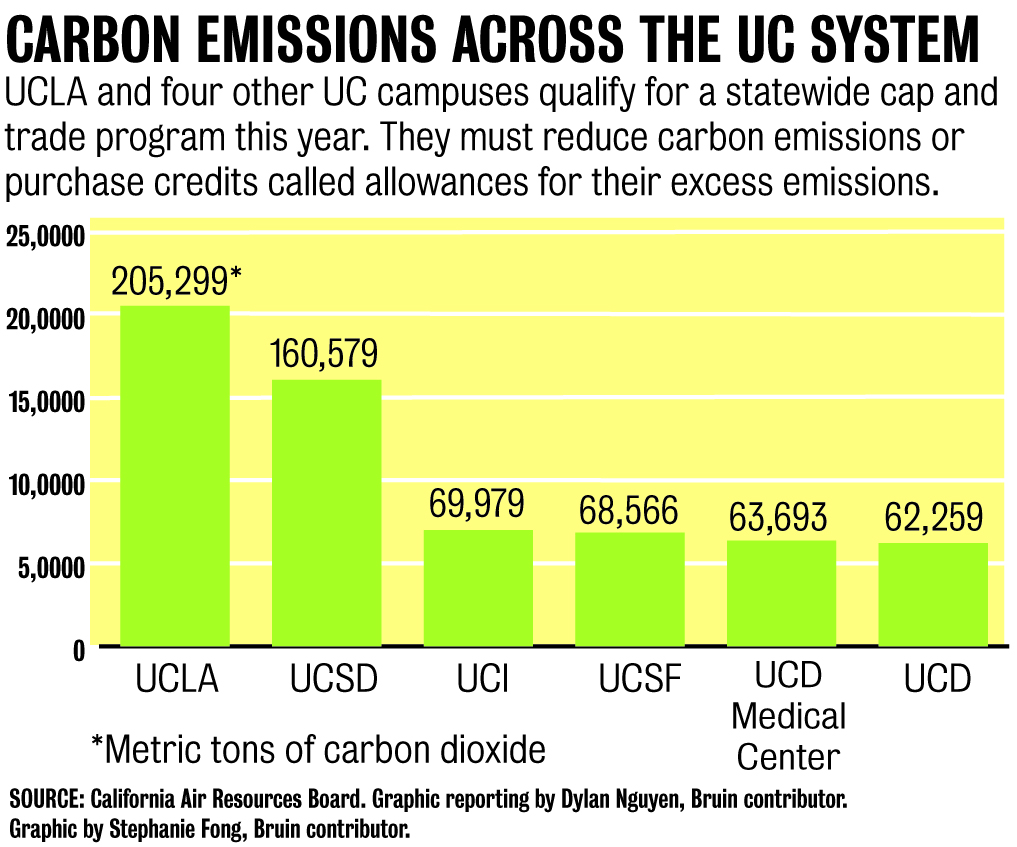UC looks to reduce carbon emissions, comply with cap and trade policies

By Dylan Nguyen
April 9, 2013 1:23 a.m.
The original version of this article contained multiple errors and has been changed. See the bottom of the article for additional information.
The University of California is currently looking to reduce its carbon emissions – beyond reductions it has undertaken on its own – to comply with a recently implemented state policy that aims to help bring California’s greenhouse gas emissions to 1990 levels by 2020.
The cap and trade program, which took effect earlier this year, sets a cap on how much carbon a business, university or any other type of property is allowed to emit. The cap for businesses and facilities is 25,000 metric tons of carbon dioxide, according to the California Air Resource Board.
If their emissions are over the limit, institutions can to purchase credits – called carbon allowances – from other institutions, or reduce their emissions to meet the cap. Institutions can sell unused credits to others at quarterly auctions, said Dave Clegern, a spokesman for the Resource Board.
UCLA and four other UC campuses including San Diego, Davis, Irvine and San Francisco emit more carbon than is allowed under the current cap. As of 2011, UCLA emits 205,299 metric tons of carbon dioxide. In total, all five campuses, including UC Davis Medical Center, released 630,375 metric tons of carbon dioxide, according to the California Air Resources Board’s website’s 2011 data.
“The costs (of cap and trade) are not cheap,” said Nurit Katz, chief sustainability officer of UCLA Sustainability.
“Although it is a legitimate concern, it is a good policy to use the market (in the auction process) to reach 1990 level goals.”
The program is expected to cost UCLA $2 to $3 million annually, Katz said. In 2012, the UC system started purchasing carbon allowances to cover for its emissions, she said.
Given its delicate budget, UC plans to propose amendments to the cap and trade program to ask the California Air Resource Board for exemptions on carbon allowances because of the actions the UC has already taken to lower emissions, Katz said.
The Resources Board posted today a summary of issues that will be addressed in the amendment process in mid-2013, Clegern said.
Unless the UC invests in capital projects to reduce emissions or is exempt from paying the allowances among other options, the system will need to continue purchasing allowances to cover for extra carbon emissions, Balistreri said.
Last month, Orange County State Senator Mimi Walters proposed a bill to completely exclude the UC from paying any carbon allowances.
The bill is set for a hearing in the State Senate on April 17, but it is unclear if the bill will pass, according to the Orange County Register.
The cap and trade policy is in line with the Global Warming Solutions Act of 2006, which set a statewide goal to return emissions levels to those in 1990 by 2020, according to Daily Bruin archives.
The last calculation of the state’s carbon emissions, which took place in 2010, stated that about 450 million metric tons of carbon dioxide were released statewide, according to the board’s website.
The 1990 levels require a statewide emissions count of 427 million metric tons of carbon, according to the Resources Board.
Opponents of the program, however, have said they think the program will add to businesses’ operating costs.
UCLA has already taken measures to reduce its carbon footprint, Katz said. Since 1990, UCLA has experienced a 40 percent growth in square footage, but has decreased carbon emissions by 27 percent per square foot, she said.
Roy Champawat, director of Ackerman Student Union, said his organization does not have a real role in cap and trade, but has invested in conservation efforts through projects like solar panels that were installed on top of Ackerman.
ASUCLA services are merely consumers of the energy services that UCLA offers, and the solar panels installed on the Ackerman Union are a means to reduce our energy demands, an idea the cap and trade program encourages, Champawat said.The UC’s proposed amendments to the cap and trade program will be reviewed by the Resources Board and the public this summer.
Because the UC has already put programs in place to reduce its carbon emissions, Katz said she is confident the California Air Resource Board will give it some exceptions for the cap and trade program.
Correction: The program is expected to cost UCLA $2 to $3 million annually, Katz said. Given its delicate budget, UC plans to propose amendments to the cap and trade program to ask the California Air Resource Board for exemptions on carbon allowances because of the actions the UC has already taken to lower emissions, Katz said. The Resources Board posted today a summary of issues that will be addressed in the amendment process in mid-2013, Clegern said.

